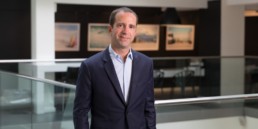Interview: GMG Radio working on a ‘hybrid’ digital future for radio
The digital revolution raging through traditional media is accelerating and radio is no different: there are growing numbers of digital and internet listeners, meaning that the business model and consumption trends are changing fast. Yes, people mostly listen via AM/FM and the stations sell advertising (or get publicly funded via the BBC) but the next few years are crucial.
As James Cridland points out, the combined audience of the Radioplayer online radio platform in the UK is 5.7 unique users a month, with more than 22 million individual sessions, a bigger audience than ITV and Channel 4 combined.
And the possibilities are huge: according to RAJAR, radio listening reached its highest level ever recorded (91.6 percent of the UK population) in the first quarter of this year.
But the BBC still looms large with an audience including more than 55 percent of the UK adult population, making the job of commercial radio brands – facing the threat of platform shift and the BBC – a tough one indeed.
One man charged with understanding all that is James Rea, who was last month appointed Guardian Media Group’s deputy group programme director. He still retains responsibility for for news output and special broadcasts, but with a lot more besides, including “developing new partnerships in the digital arena to extend the group’s content to new audiences,” according to the company.
According to figures from last October, one in four listeners of GMG stations (which comprises Rock, Real and Smooth radio) audience are tuning-in via a digital/online platform. I caught up with Rea to ask him what the plans are…
Saatchi mobile marketer: Mobile web is better value than apps
We all know that mobile is a rapidly evolving marketplace packed with plenty of sleek shiny gizmos – but it’s all too easy to be dazzled by the newest toy and forget the basics. James Hilton, joint managing director of M&C Saatchi Mobile, says commercial success comes from creative and effective communication – and you don’t need an app to get it.
Just five years ago when the company was founded as the independent agency Inside Mobile, mobile content was a tricky terrain. Phone apps were created in Java and required individual builds which, even after a considerable investment, wouldn’t necessarily run on all handsets.
The irresistible rise of the smartphone
But now smartphones have revolutionised how and when we interact with the web and online-enabled apps. Hilton believes a major shift in perception came from the stability that the Apple store and the iPhone platform provided.
But development costs are high. In order to get a successful uptake there needs to be considerable investment and bug testing. When the app is launched it needs to be closely monitored and promoted carefully to be picked up in the Apple Store or Android Market.
Nevertheless if he had £10,000 to spend on a campaign, he’d opt for a mobile site rather than an app:
“This makes it agnostic of all technology so all users are open to the opportunity. If you are designing for mobile internet then the content needs to be a lot shorter and more snackable.”
The bad old days
Illustrating what can be done without apps – and that people have been doing this stuff intelligently for years – Hilton mentions one of Inside Mobile’s most award-winning campaigns was for Reebok, built around the 2008 NBA basketball playoff final. The campaign combined branded SMS and ringtones while greater context and exclusive content was carried by voice messages and a WAP-enabled microsite.
See it for yourself:
Resistance to viral
Whilst certain things stay the same there is no longer a secret formula for making digital or mobile content go viral. In fact it’s much more difficult to do this now given the number of agencies specifically trying to make their product take off on forums YouTube….
“In 2000 almost everything on the internet was viral. Now we find that our audience has matured and become more sophisticated. We can still provide the touchpoints for viral – allowing sharing of something using social media – but it’s difficult to predict what will work.”
Apps are currently leading the mobile media debate but perhaps this won’t always remain this way – according to Hilton, something very close to all phones around today can access the internet. He anticipates that because of increasing deployment of Google’s Android operating system, there will be some innovative use of HTML 5 on the horizon – and the boundaries between apps and the web will start to blur.
“We’re finding the lines between mobile and digital is blurring. Companies such as M&C Saatchi appreciated that their clients want to move smoothly between different platforms. Mobile is now integrated and at the heart of the business.”
For more vital analysis and case studies on the evolution of mobile media, come to Mobile Media Strategies 2011 on June 14 in London, the second-full-length conference from TheMediaBriefing.
Originally published on TheMediaBriefing

